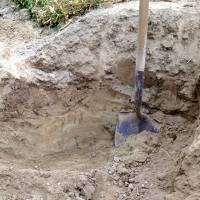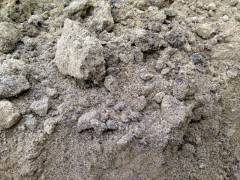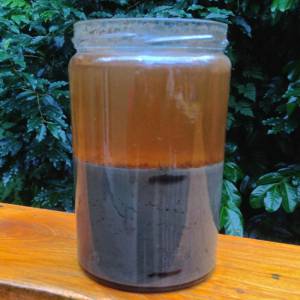Table of Contents
Types of soil
This is only a brief introduction to the physical components of soil. It doesn't include a discussion of soil fertility. Soil contains at a minimum sand, silt and clay. The relative proportions of those components determines the physical nature of the soil. The range of soils I work with go from sandy loam (primarily sand and silt, with a small amount of clay) to predominately clay (very little sand and silt and lots of clay). (Minerals, micro-organisms and organic matter determine the fertility of the soil.)
Sandy loam
My main garden has Puyallup sandy loam. It is a mixture of river sand, silt and clay. Physically, this is the nicest soil I have ever worked in. It is very deep, and drains well.

 In the photo at the left you can see the sandy loam on top and the river sand below (notice the different soil at the top of the shovel). On the right is a photo of the soil with more sand that lies below the loam.
In the photo at the left you can see the sandy loam on top and the river sand below (notice the different soil at the top of the shovel). On the right is a photo of the soil with more sand that lies below the loam.
Puyallup sandy loam soils are on floodplains and low terraces, especially in the river valleys near a river.
I haven't done a physical soil test of this garden, but the nature of this soil is pretty obvious. What has also been obvious is that the soil is not especially fertile, lacking organic matter and necessary minerals and trace elements, such as calcium, magnesium, and, of course, nitrogen.
I have been amending the soil with green manure cover crops, organic fertilizer and quality compost, so I have seen noticeable improvement in the previous 18 months.
Clay
The soil in another garden down by the river contains the same elements, except it is 90% (or more) clay - see the next section for the results of a soil test. This is not sandy loam. There are pros and cons to clay soil for a gardener.
A positive aspect is that clay retains water and capillary action keeps moisture coming up from below. As far as I know, that's it for the pros.
Even if clay is fertile (if that's possible) and has all the nutrients a plant needs, it is reluctant to release those to the plant's roots. It takes lots of lime (ag lime and dolomite lime) to allow the chemical balance that releases nutrients to the plants. It also takes lots of compost.
Clay does not drain well (which can be a plus within limits) so it can get waterlogged. Because it retains moisture and requires a considerable amount of compost, it eventually attracts symphidens, bugs that eat the tips of plant roots.
Soil test
 The photo shows the result of an at-home physical soil test of the clay soil in a garden near the Snoqualmie river.
The photo shows the result of an at-home physical soil test of the clay soil in a garden near the Snoqualmie river.
I conducted this test by taking a quart or so of the soil in a specific area (the one where I am growing tomatoes), mashing out the little clods, filtering out organic matter, adding water and shaking thoroughly.
The first particles to fall to the bottom are grains of sand (takes about 2 minutes). Next is the silt (in about 2 hours). Finally, the various weights of clay, which take from 2 days to a month to precipitate down from the remaining mixture.
The area below the bottom mark on the jar represents the amount of sand and silt in the sample. I really couldn't tell that there was any sand in this sample, but whatever there was had to be beneath the (very small) amount of silt.
Above the top mark are the very fine clay particles that took weeks to fall down. The clear part at top is the water through which the soil particles have precipitated.
I conclude from this test that the soil sample was more than 90% clay. Steve Solomon says that it very difficult to grow organic vegetables in a mixture of more than 50% clay. But I had already assembled my hoop house and prepared the soil for transplanting. I knew this would be a trip. See the page on growing tomatoes in a hoop house for details.
Raised beds at home
My home raised bed gardens are sitting on either glacial til (packed gravel and rocks) or Tokul soil, a thin layer of top soil (containing decomposed forest products and volcanic ash) over clay or gravel or glacial till. Tokul soil is fine for growing evergreen trees but lousy for vegetables. That's why I have raised beds for my home garden.
So where does the soil in the raised beds come from? That's a problem. It has taken several years composting and amending “imported soil” to reach a stage where vegetables grow. The imported soil came from commercial composters who depend on “forest products” (wood and leaves), which like Tokul soil are good for trees and shrubs, but not okay by themselves for vegetable gardening.
